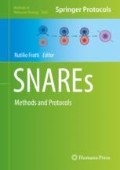Abstract
SNARE-mediated membrane fusion is required for membrane trafficking as well as organelle biogenesis and homeostasis. The membrane fusion reaction involves sequential formation of hemifusion intermediates, whereby lipid monolayers partially mix on route to complete bilayer merger. Studies of the Saccharomyces cerevisiae lysosomal vacuole have revealed many of the fundamental mechanisms that drive the membrane fusion process, as well as features unique to organelle fusion. However, until recently, it has not been amenable to electron microscopy methods that have been invaluable for studying hemifusion in other model systems. Herein, we describe a method to visualize hemifusion intermediates during homotypic vacuole membrane fusion in vitro by transmission electron microscopy (TEM), electron tomography, and cryogenic electron microscopy (cryoEM). This method facilitates acquisition of invaluable ultrastructural data needed to comprehensively understand how fusogenic lipids and proteins contribute to SNARE-mediated membrane fusion-by-hemifusion and the unique features of organelle versus small-vesicle fusion.
Access this chapter
Tax calculation will be finalised at checkout
Purchases are for personal use only
References
Wickner W (2010) Membrane fusion: five lipids, four SNAREs, three chaperones, two nucleotides, and a Rab, all dancing in a ring on yeast vacuoles. Annu Rev Cell Dev Biol 26:115–136
Wang L, Merz AJ, Collins KM, Wickner W (2003) Hierarchy of protein assembly at the vertex ring domain for yeast vacuole docking and fusion. J Cell Biol 160:365–374
Fratti RA, Jun Y, Merz AJ, Margolis N, Wickner WT (2004) Interdependent assembly of specific regulatory lipids and membrane fusion proteins into the vertex ring domain of docked vacuoles. J Cell Biol 167:1087–1098
Schwartz ML, Merz AJ (2009) Capture and release of partially zipped trans-SNARE complexes on intact organelles. J Cell Biol 185:535–549
Wang L, Seeley ES, Wickner W, Merz AJ (2002) Vacuole fusion at a ring of vertex docking sites leaves membrane fragments within the organelle. Cell 108:357–369
McNally EK, Karim MA, Brett CL (2017) Selective lysosomal transporter degradation by organelle membrane fusion. Dev Cell 40:151–167
Wickner W, Rizo J (2017) A cascade of multiple proteins and lipids catalyzes membrane fusion. Mol Biol Cell 28:707–711
Chernomordik LV, Kozlov MM (2008) Mechanics of membrane fusion. Nat Struct Mol Biol 15:675–683
Hernandez JM, Stein A, Behrmann E, Riedel D, Cypionka A, Farsi Z, Walla PJ, Raunser S, Jahn R (2012) Membrane fusion intermediates via directional and full assembly of the SNARE complex. Science 336:1581–1584
Risselada HJ, Bubnis G, Grubmüller H (2014) Expansion of the fusion stalk and its implication for biological membrane fusion. Proc Natl Acad Sci U S A 111:11043–11048
Warner JM, O'Shaughnessy B (2012) Evolution of the hemifused intermediate on the pathway to membrane fusion. Biophys J 103:689–701
Reese C, Mayer A (2005) Transition from hemifusion to pore opening is rate limiting for vacuole membrane fusion. J Cell Biol 171:981–990
D'Agostino M, Risselada HJ, Mayer A (2016) Steric hindrance of SNARE transmembrane domain organization impairs the hemifusion-to-fusion transition. EMBO Rep 17:1590–1608
Diao J, Grob P, Cipriano DJ, Kyoung M, Zhang Y, Shah S, Nguyen A, Padolina M, Srivastava A, Vrljic M, Shah A, Nogales E, Chu S, Brunger AT (2012) Synaptic proteins promote calcium-triggered fast transition from point contact to full fusion. elife 1:e00109
Zampighi GA, Zampighi LM, Fain N, Lanzavecchia S, Simon SA, Wright EM (2006) Conical electron tomography of a chemical synapse: vesicles docked to the active zone are hemi-fused. Biophys J 91:2910–2918
Jun Y, Wickner W (2007) Assays of vacuole fusion resolve the stages of docking, lipid mixing, and content mixing. Proc Natl Acad Sci U S A 104:13010–13015
Mattie S, McNally EK, Karim MA, Vali H, Brett CL (2017) How and why intralumenal membrane fragments form during vacuolar lysosome fusion. Mol Biol Cell 28:309–321
Reese C, Heise F, Mayer A (2005) Trans-SNARE pairing can precede a hemifusion intermediate in intracellular membrane fusion. Nature 436:410–414
Pieren M, Schmidt A, Mayer A (2010) The SM protein Vps33 and the t-SNARE H(abc) domain promote fusion pore opening. Nat Struct Mol Biol 17:710–717
Karunakaran S, Fratti RA (2013) The lipid composition and physical properties of the yeast vacuole affect the hemifusion-fusion transition. Traffic 14:650–662
Horst M, Knecht EC, Schu PV (1999) Import into and degradation of cytosolic proteins by isolated yeast vacuoles. Mol Biol Cell 10:2879–2889
Michaillat L, Baars TL, Mayer A (2012) Cell-free reconstitution of vacuole membrane fragmentation reveals regulation of vacuole size and number by TORC1. Mol Biol Cell 23:881–895
Haas A (1995) A quantitative assay to measure homotypic vacuole fusion in vitro. Methods Cell Sci 17:283–294
Peddie CJ, Collinson LM (2014) Exploring the third dimension: volume electron microscopy comes of age. Micron 61:9–19
Reynolds ES (1963) The use of lead citrate at high pH as an electron-opaque stain in electron microscopy. J Cell Biol 17:208–212
Acknowledgments
We thank K. Basu and staff members at the Facility for Electron Microscopy Research at McGill University (Montreal, Canada) for technical assistance. S.M. was supported by a Natural Sciences and Engineering Research Council of Canada Undergraduate Student Research Award and a Fonds de Recherche du Québec Summer Research Scholarship. This work was supported by Natural Sciences and Engineering Research Council of Canada grants RGPIN/403537-2011 and RGPIN/2017-06652 to C.L.B.
Author information
Authors and Affiliations
Corresponding author
Editor information
Editors and Affiliations
Rights and permissions
Copyright information
© 2019 Springer Science+Business Media, LLC, part of Springer Nature
About this protocol
Cite this protocol
Mattie, S., Kazmirchuk, T., Mui, J., Vali, H., Brett, C.L. (2019). Visualization of SNARE-Mediated Organelle Membrane Hemifusion by Electron Microscopy. In: Fratti, R. (eds) SNAREs. Methods in Molecular Biology, vol 1860. Humana Press, New York, NY. https://doi.org/10.1007/978-1-4939-8760-3_24
Download citation
DOI: https://doi.org/10.1007/978-1-4939-8760-3_24
Published:
Publisher Name: Humana Press, New York, NY
Print ISBN: 978-1-4939-8759-7
Online ISBN: 978-1-4939-8760-3
eBook Packages: Springer Protocols

